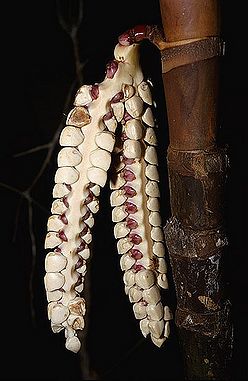Dypsis mirabilis
| Dypsis (DIP-sis) mirabilis (mihr-ah-BIHL-iss) | |||||||
|---|---|---|---|---|---|---|---|
 Inflorescence at Pistillate Anthesis (Prophyll Caducous). Photo by Dr. Henk Beentje, Royal Botanic Gardens, Kew/Palmweb. | |||||||
| Scientific Classification | |||||||
| |||||||
| Synonyms | |||||||
|
| |||||||
| Native Continent | |||||||
|
| |||||||
| Morphology | |||||||
| |||||||
| Culture | |||||||
|
| |||||||
| Survivability index | |||||||
|
| |||||||
| Common names | |||||||
|
| |||||||
Contents
Habitat and Distribution
Endemic to Madagascar. Marojejy and environs. Lowland forest in valley bottoms; alt. 90-200 m.Description
Solitary understory palm. STEM to 2.5 m tall, to 15 mm in diam., internodes about 40 mm long. LEAVES about 7 in the crown; sheath 24 cm long, about 25 mm in diam., longitudinally striate, sparsely scaly, the sheath mouth with an irregularly tattering brown membranous margin; petiole about 11 cm, adaxially channelled, abaxially ± rounded, covered with abundant caducous dark brown scales; rachis about 85 cm; blade irregularly divided into 3-4 broad long acuminate leaflets on each side of the rachis, basal leaflets about 80 x 11 cm, mid-leaf leaflets 70 x 4-7 cm, apical leaflets 52 x 7-8.5 cm, shallowly lobed distally, leaflet texture rather thin in dried specimens, glabrous, short transverse veinlets evident. INFLORESCENCE interfoliar, branching to 2 orders, to about 115 cm long; peduncle 45 cm long, densely covered with dark red indumentum; prophyll and peduncular bract lacking in available material; rachis about 70 cm long, covered with indumentum as the peduncle; rachillae ± pendulous, very numerous (about 100), 12-16 cm long, about 2 mm in diam., glabrous, tending to be narrow just above the triad insertion, triads 1-3 mm apart, rachilla bract about 0.5 x 2 mm. STAMINATE FLOWERS at anthesis rounded, orange, about 1.8 mm in diam.; sepals 1.0 x 0.9 mm, apically erose, keeled; petals rounded triangular, 1.5 x 1.3 mm, striate; stamens 3, antesepalous, emerging slightly between the petals at anthesis, filaments terete, 1.1 mm long, about 0.5 mm wide at base, tapering to 0.3 mm wide at tip, anthers didymous, 0.4 x 0.1 mm; staminodes antepetalous, filaments adnate to the central pyramidal pistillode forming a composite structure about 1.1 x 0.7 mm, the filaments about 1.1 x 0.2 mm, free at the very tip, empty anthers about 0.1 x 0.1 mm, free pistillode about 0.1 mm high. PISTILLATE FLOWERS known only in very immature bud; sepals in fruit triangular, about 1 x 1 mm; petals in fruit triangular, striate, about 2 x 2 mm; staminodes 6. Immature FRUIT ovoid, green, 12 x 7 mm; endocarp composed of brown fibres. SEED 9 x 5 mm; endosperm homogeneous. (J. Dransfield and H. Beentje. 1995)/Palmweb. Editing by edric.
The antesepalous stamens have didymous anthers (unusual among species with three stamens where, if the stamens are antesepalous, they are usually sagittate), but the most unusual feature is that there are three well developed staminodes that are adnate by their filaments to the pistillode, thus forming a large pyramidal body in the centre of the flower. The relationships of this species are obscure. Beentje & Andriampaniry 4687 has very young flower buds; nevertheless, three large antesepalous stamens and three minute central fused staminodes are visible. It is possible that Casimir 11731 (K, P) from Maroambihy, Sambava, also belongs here; inflorescence structure and vegetative features are similar, but no staminate flowers are available to confirm the identity. (J. Dransfield and H. Beentje. 1995)/Palmweb.
Culture
Cold Hardiness Zone: 10a
Comments and Curiosities
There is nothing particularly unusual about the vegetative morphology of this species. It is a single-stemmed palm of the undergrowth of moderate size, with leaves that are divided into few broad leaflets, a habit common among undergrowth dypsids. The species name means wonderful, which may seem inappropriate for a rather ordinary looking palm. However, this species has most unusual staminodes in the staminate flower, and it is this rather obscure feature that caused us wonder. (J. Dransfield and H. Beentje. 1995)/Palmweb.
- IMAGE GALLERY
External Links
References
Phonetic spelling of Latin names by edric.
Special thanks to Geoff Stein, (Palmbob) for his hundreds of photos.
Special thanks to Palmweb.org, Dr. John Dransfield, Dr. Bill Baker & team, for their volumes of information and photos.
Glossary of Palm Terms; Based on the glossary in Dransfield, J., N.W. Uhl, C.B. Asmussen-Lange, W.J. Baker, M.M. Harley & C.E. Lewis. 2008. Genera Palmarum - Evolution and Classification of the Palms. Royal Botanic Gardens, Kew. All images copyright of the artists and photographers (see images for credits).
Dransfield, J. & Beentje, H. 1995. The Palms of Madagascar. Royal Botanic Gardens, Kew and The International Palm Society.
Many Special Thanks to Ed Vaile for his long hours of tireless editing and numerous contributions.







































































































